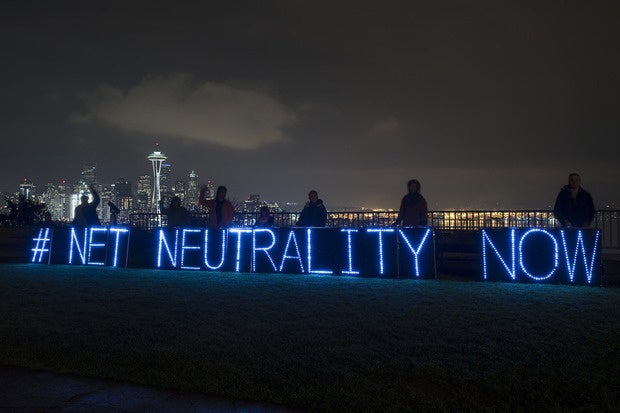Now that Trump has taken office and is adorning his cabinet with fellow millionaires and billionaires, net neutrality is on the chopping block. The principle that all internet traffic should be treated equally is all but dead. With net neutrality, Amazon, for example, can’t cut a deal with Time Warner to make its website come up faster than Walmart’s. For all the talk of being for the common man, this administration won’t stand in the way of big businesses making deals.
The internet was built on the very idea of net neutrality. It has a history going back more than a century in “common carrier” laws, when Standard Oil was fined for creating a deal with a railroad (also a common carrier) in which it got a “rebate” whenever a competitor shipped oil on the line. These kinds of deals create vertical monopolies to the disadvantage of consumers, escalating prices. They also stifle innovation as they price access to the market out of the reach of startups and inventors.
Take the cable business. Spectrum (Charter Communications) controls about a third of the market for internet access with no viable alternatives in many areas of the country (including Durham, N.C., where I live), and that’s less than Comcast’s share.
This monopoly is half-natural. There is only so much room in municipal and county infrastructure for cables, so access to build a competitive service in the ground is limited. Railroads and power companies are considered “natural monopolies” and are heavily regulated, some with price controls. Cable TV is also often price-limited (but it’s merely a matter of lobbying each year to raise this limit). However, this cable market monopoly is only half-natural because these corporations spend a lot of money lobbying to stifle competition.
All is not rosy with the cable corporations. They slept on the change to their mainline business. The days of rushing home to watch your favorite TV show or programming your VCR or DVR to record it are over. Streaming services like Netflix are eating into subscription to broadcast TV. Even live sports ball, the last haven of television, can usually be streamed. Cable companies have tried to get a cut by buying into other premium content providers and have invested in top-rated shows on their own, but the threat is real. Broadband should naturally become a commodity product with the profit in content and services.
Because of all this, Obama’s FCC chairman Tom Wheeler put rules in place to ensure that net neutrality would rule. Your friendly neighborhood cellular companies were already flouting the rules by offering “zero rated” streaming services, meaning that streaming on their network didn’t count against your monthly limit but using a competitor’s would. (Unfortunately, their streaming services also suck, offering mostly crap you already don’t watch on YouTube.)
Fast-forward to 2017 and the small-handed guy with the undersized inaugural crowd has appointed Ajit Pai, who wouldn’t even have coffee with Wheeler when he was in charge, as the new chair of the FCC. Pai is a true lackey of the cable companies and opposes net neutrality. The great pumpkin himself also stated his opposition to net neutrality (along with Gwyneth Paltrow). He sees it as somehow stifling conservative media and as an unnecessary government regulation requiring relief.
The end of net neutrality should be a boon to your friendly neighborhood cable or telecom monopolist, but what will it mean for you?
Target 1: Netflix
The people have spoken. At this point Netflix and other services (but mainly Netflix) are the bulk of bandwidth. Cable companies have already worked to get a bigger cut from Netflix; basically, Netflix paid to get a better connection. That was with the FCC and Netflix suing in opposition. However, with a cable friend in the FCC, I bet the price goes up. There may even be a tier that isn’t available to the market and is reserved for the services owned by the cable companies. You’re going to pay that $100 per month, and by golly you’ll get less and like it!
Target 2: Rates and bandwidth
My rate for bandwidth has been falling. I have 100Mbps down and 10Mbps up. It wasn’t long ago that I paid about $80 for that, but now I’m paying about $50 per month. With imminent competition from Google and the threat of redundancy, my provider was dropping rates to keep you hooked. However, there will be less pressure now. The rate probably won’t go up much, but it will probably stop dropping.
Part of the reason my rates have dropped is that I’ve kept the same speed for a while. I’d love the 300Mbps, but I didn’t feel like buying a new cable modem, and every cable modem that Time Warner (now Spectrum) gave me was defective. I’m a second-tier home subscriber now.
Less competition and higher profit from a vertical monopoly that owns the infrastructure, the content, and the content provider will mean fewer reasons to upgrade the bandwidth. Our only hope is the combed-over wonder will find that a YouTube video he tweets doesn’t load fast enough.
Target 3: The great internet tax
Inevitably if you control all of the on-ramps you can toll everyone, not only Netflix. Eventually the cut won’t be big enough and a profit-maximizing monopoly will do what a profit-maximizing monopoly does. It’ll expand its cut of the market and restrict the supply and raise the price to control costs and maximize profit. The supply is infrastructure costs and bandwidth and unique or decent content/services. Once you achieve that, horizontal expenditure (that is, making your favorite content or service providers, such as Google or Salesforce, all pay a bigger fee) is the only source of new profits (and a strategy to restrict supply).
We’re a little ways off from the full implementation of this plan. The unraveling of the open internet is only about to begin. So sit back and enjoy the internet Trumpocalypse.






